DFH-GAN: A Deep Face Hashing with Generative Adversarial Network
Bo Xiao,
Lanxiang Zhou,
Yifei Wang,
Qiangfang Xu

Auto-TLDR; Deep Face Hashing with GAN for Face Image Retrieval
Similar papers
VSB^2-Net: Visual-Semantic Bi-Branch Network for Zero-Shot Hashing
Xin Li, Xiangfeng Wang, Bo Jin, Wenjie Zhang, Jun Wang, Hongyuan Zha

Auto-TLDR; VSB^2-Net: inductive zero-shot hashing for image retrieval
Abstract Slides Poster Similar
Hierarchical Deep Hashing for Fast Large Scale Image Retrieval
Yongfei Zhang, Cheng Peng, Zhang Jingtao, Xianglong Liu, Shiliang Pu, Changhuai Chen

Auto-TLDR; Hierarchical indexed deep hashing for fast large scale image retrieval
Abstract Slides Poster Similar
Object Classification of Remote Sensing Images Based on Optimized Projection Supervised Discrete Hashing
Qianqian Zhang, Yazhou Liu, Quansen Sun

Auto-TLDR; Optimized Projection Supervised Discrete Hashing for Large-Scale Remote Sensing Image Object Classification
Abstract Slides Poster Similar
SATGAN: Augmenting Age Biased Dataset for Cross-Age Face Recognition
Wenshuang Liu, Wenting Chen, Yuanlue Zhu, Linlin Shen

Auto-TLDR; SATGAN: Stable Age Translation GAN for Cross-Age Face Recognition
Abstract Slides Poster Similar
Improved Deep Classwise Hashing with Centers Similarity Learning for Image Retrieval

Auto-TLDR; Deep Classwise Hashing for Image Retrieval Using Center Similarity Learning
Abstract Slides Poster Similar
Learning Disentangled Representations for Identity Preserving Surveillance Face Camouflage
Jingzhi Li, Lutong Han, Hua Zhang, Xiaoguang Han, Jingguo Ge, Xiaochu Cao

Auto-TLDR; Individual Face Privacy under Surveillance Scenario with Multi-task Loss Function
DAIL: Dataset-Aware and Invariant Learning for Face Recognition
Gaoang Wang, Chen Lin, Tianqiang Liu, Mingwei He, Jiebo Luo

Auto-TLDR; DAIL: Dataset-Aware and Invariant Learning for Face Recognition
Abstract Slides Poster Similar
Cross-Media Hash Retrieval Using Multi-head Attention Network
Zhixin Li, Feng Ling, Chuansheng Xu, Canlong Zhang, Huifang Ma

Auto-TLDR; Unsupervised Cross-Media Hash Retrieval Using Multi-Head Attention Network
Abstract Slides Poster Similar
Cross-spectrum Face Recognition Using Subspace Projection Hashing
Hanrui Wang, Xingbo Dong, Jin Zhe, Jean-Luc Dugelay, Massimo Tistarelli

Auto-TLDR; Subspace Projection Hashing for Cross-Spectrum Face Recognition
Abstract Slides Poster Similar
Unsupervised Disentangling of Viewpoint and Residues Variations by Substituting Representations for Robust Face Recognition
Minsu Kim, Joanna Hong, Junho Kim, Hong Joo Lee, Yong Man Ro

Auto-TLDR; Unsupervised Disentangling of Identity, viewpoint, and Residue Representations for Robust Face Recognition
Abstract Slides Poster Similar
SoftmaxOut Transformation-Permutation Network for Facial Template Protection
Hakyoung Lee, Cheng Yaw Low, Andrew Teoh

Auto-TLDR; SoftmaxOut Transformation-Permutation Network for C cancellable Biometrics
Abstract Slides Poster Similar
Fast Discrete Cross-Modal Hashing Based on Label Relaxation and Matrix Factorization
Donglin Zhang, Xiaojun Wu, Zhen Liu, Jun Yu, Josef Kittler

Auto-TLDR; LRMF: Label Relaxation and Discrete Matrix Factorization for Cross-Modal Retrieval
Discrete Semantic Matrix Factorization Hashing for Cross-Modal Retrieval
Jianyang Qin, Lunke Fei, Shaohua Teng, Wei Zhang, Genping Zhao, Haoliang Yuan

Auto-TLDR; Discrete Semantic Matrix Factorization Hashing for Cross-Modal Retrieval
Abstract Slides Poster Similar
High Resolution Face Age Editing
Xu Yao, Gilles Puy, Alasdair Newson, Yann Gousseau, Pierre Hellier

Auto-TLDR; An Encoder-Decoder Architecture for Face Age editing on High Resolution Images
Abstract Slides Poster Similar
Label Self-Adaption Hashing for Image Retrieval
Jianglin Lu, Zhihui Lai, Hailing Wang, Jie Zhou

Auto-TLDR; Label Self-Adaption Hashing for Large-Scale Image Retrieval
Abstract Slides Poster Similar
Identity-Preserved Face Beauty Transformation with Conditional Generative Adversarial Networks

Auto-TLDR; Identity-preserved face beauty transformation using conditional GANs
Abstract Slides Poster Similar
Age Gap Reducer-GAN for Recognizing Age-Separated Faces
Daksha Yadav, Naman Kohli, Mayank Vatsa, Richa Singh, Afzel Noore

Auto-TLDR; Generative Adversarial Network for Age-separated Face Recognition
Abstract Slides Poster Similar
Leveraging Quadratic Spherical Mutual Information Hashing for Fast Image Retrieval
Nikolaos Passalis, Anastasios Tefas
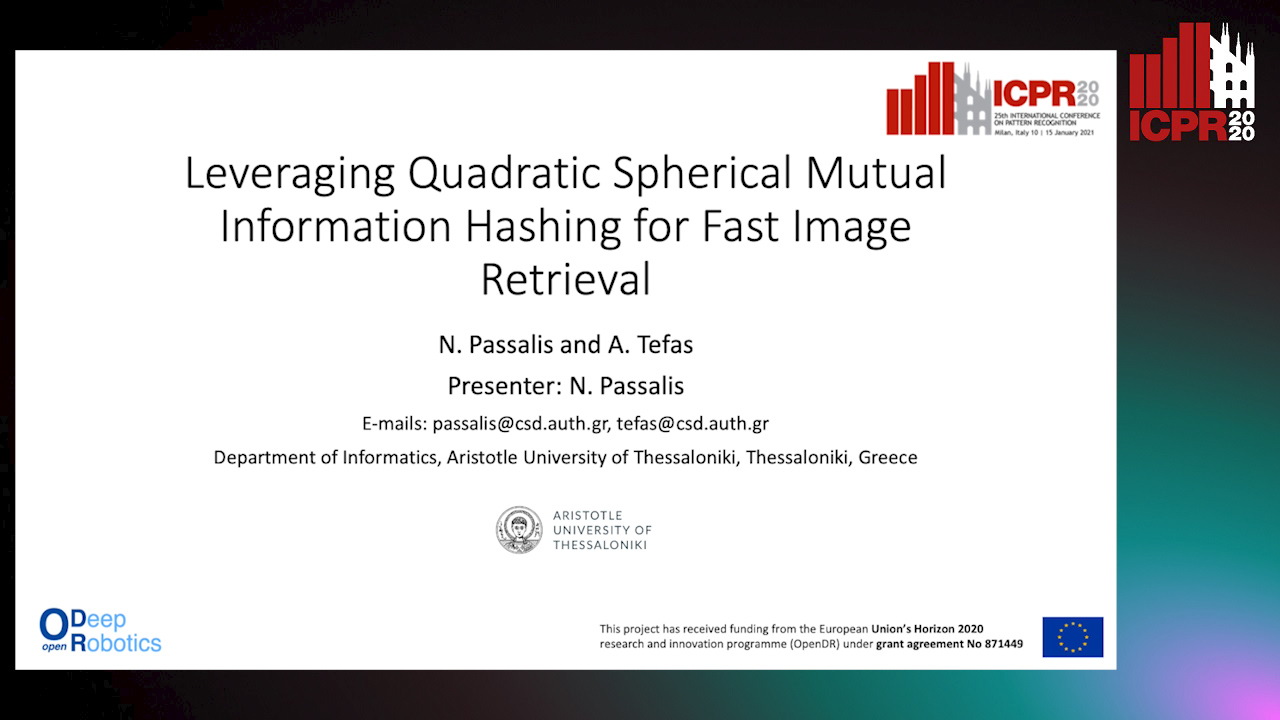
Auto-TLDR; Quadratic Mutual Information for Large-Scale Hashing and Information Retrieval
Abstract Slides Poster Similar
Local Facial Attribute Transfer through Inpainting
Ricard Durall, Franz-Josef Pfreundt, Janis Keuper

Auto-TLDR; Attribute Transfer Inpainting Generative Adversarial Network
Abstract Slides Poster Similar
Unsupervised Face Manipulation Via Hallucination
Keerthy Kusumam, Enrique Sanchez, Georgios Tzimiropoulos

Auto-TLDR; Unpaired Face Image Manipulation using Autoencoders
Abstract Slides Poster Similar
Group-Wise Feature Orthogonalization and Suppression for GAN Based Facial Attribute Translation
Zhiwei Wen, Haoqian Wu, Weicheng Xie, Linlin Shen
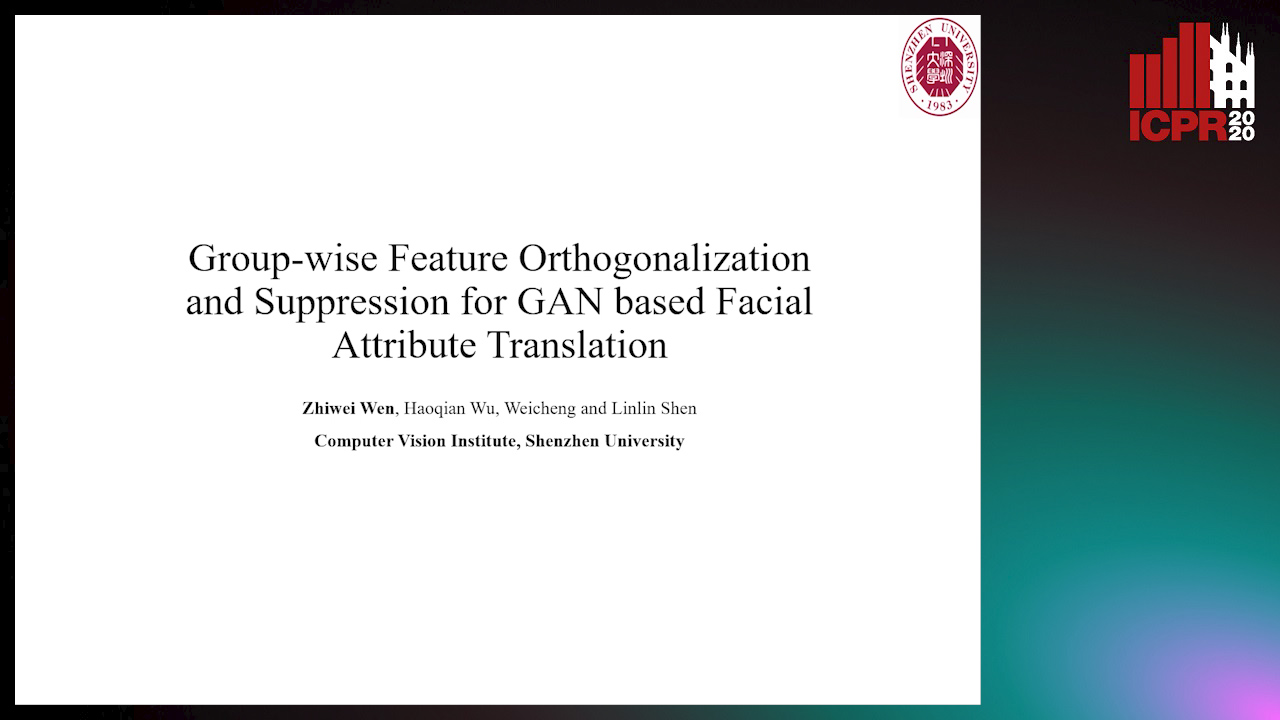
Auto-TLDR; Semantic Disentanglement of Generative Adversarial Network
Abstract Slides Poster Similar
Angular Sparsemax for Face Recognition
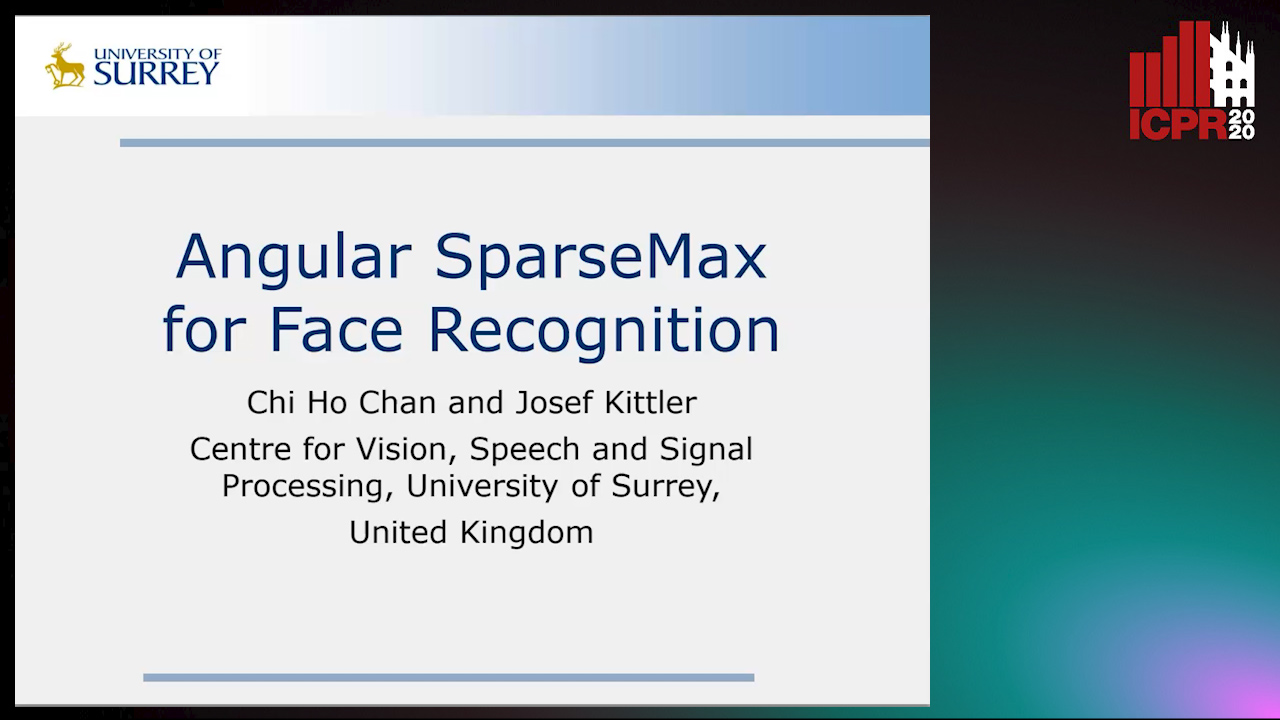
Auto-TLDR; Angular Sparsemax for Face Recognition
Abstract Slides Poster Similar
Super-Resolution Guided Pore Detection for Fingerprint Recognition
Syeda Nyma Ferdous, Ali Dabouei, Jeremy Dawson, Nasser M. Nasarabadi

Auto-TLDR; Super-Resolution Generative Adversarial Network for Fingerprint Recognition Using Pore Features
Abstract Slides Poster Similar
Continuous Learning of Face Attribute Synthesis
Ning Xin, Shaohui Xu, Fangzhe Nan, Xiaoli Dong, Weijun Li, Yuanzhou Yao

Auto-TLDR; Continuous Learning for Face Attribute Synthesis
Abstract Slides Poster Similar
Exemplar Guided Cross-Spectral Face Hallucination Via Mutual Information Disentanglement
Haoxue Wu, Huaibo Huang, Aijing Yu, Jie Cao, Zhen Lei, Ran He

Auto-TLDR; Exemplar Guided Cross-Spectral Face Hallucination with Structural Representation Learning
Abstract Slides Poster Similar
Controllable Face Aging

Auto-TLDR; A controllable face aging method via attribute disentanglement generative adversarial network
Abstract Slides Poster Similar
Multi-Label Contrastive Focal Loss for Pedestrian Attribute Recognition
Xiaoqiang Zheng, Zhenxia Yu, Lin Chen, Fan Zhu, Shilong Wang

Auto-TLDR; Multi-label Contrastive Focal Loss for Pedestrian Attribute Recognition
Abstract Slides Poster Similar
Unsupervised Contrastive Photo-To-Caricature Translation Based on Auto-Distortion
Yuhe Ding, Xin Ma, Mandi Luo, Aihua Zheng, Ran He

Auto-TLDR; Unsupervised contrastive photo-to-caricature translation with style loss
Abstract Slides Poster Similar
Attributes Aware Face Generation with Generative Adversarial Networks
Zheng Yuan, Jie Zhang, Shiguang Shan, Xilin Chen

Auto-TLDR; AFGAN: A Generative Adversarial Network for Attributes Aware Face Image Generation
Abstract Slides Poster Similar
Contrastive Data Learning for Facial Pose and Illumination Normalization

Auto-TLDR; Pose and Illumination Normalization with Contrast Data Learning for Face Recognition
Abstract Slides Poster Similar
Free-Form Image Inpainting Via Contrastive Attention Network
Xin Ma, Xiaoqiang Zhou, Huaibo Huang, Zhenhua Chai, Xiaolin Wei, Ran He

Auto-TLDR; Self-supervised Siamese inference for image inpainting
Local-Global Interactive Network for Face Age Transformation
Jie Song, Ping Wei, Huan Li, Yongchi Zhang, Nanning Zheng

Auto-TLDR; A Novel Local-Global Interaction Framework for Long-span Face Age Transformation
Abstract Slides Poster Similar
RGB-Infrared Person Re-Identification Via Image Modality Conversion
Huangpeng Dai, Qing Xie, Yanchun Ma, Yongjian Liu, Shengwu Xiong

Auto-TLDR; CE2L: A Novel Network for Cross-Modality Re-identification with Feature Alignment
Abstract Slides Poster Similar
Multi-Domain Image-To-Image Translation with Adaptive Inference Graph
The Phuc Nguyen, Stéphane Lathuiliere, Elisa Ricci

Auto-TLDR; Adaptive Graph Structure for Multi-Domain Image-to-Image Translation
Abstract Slides Poster Similar
Multi-Laplacian GAN with Edge Enhancement for Face Super Resolution

Auto-TLDR; Face Image Super-Resolution with Enhanced Edge Information
Abstract Slides Poster Similar
Supporting Skin Lesion Diagnosis with Content-Based Image Retrieval
Stefano Allegretti, Federico Bolelli, Federico Pollastri, Sabrina Longhitano, Giovanni Pellacani, Costantino Grana

Auto-TLDR; Skin Images Retrieval Using Convolutional Neural Networks for Skin Lesion Classification and Segmentation
Abstract Slides Poster Similar
Exploiting Local Indexing and Deep Feature Confidence Scores for Fast Image-To-Video Search
Savas Ozkan, Gözde Bozdağı Akar
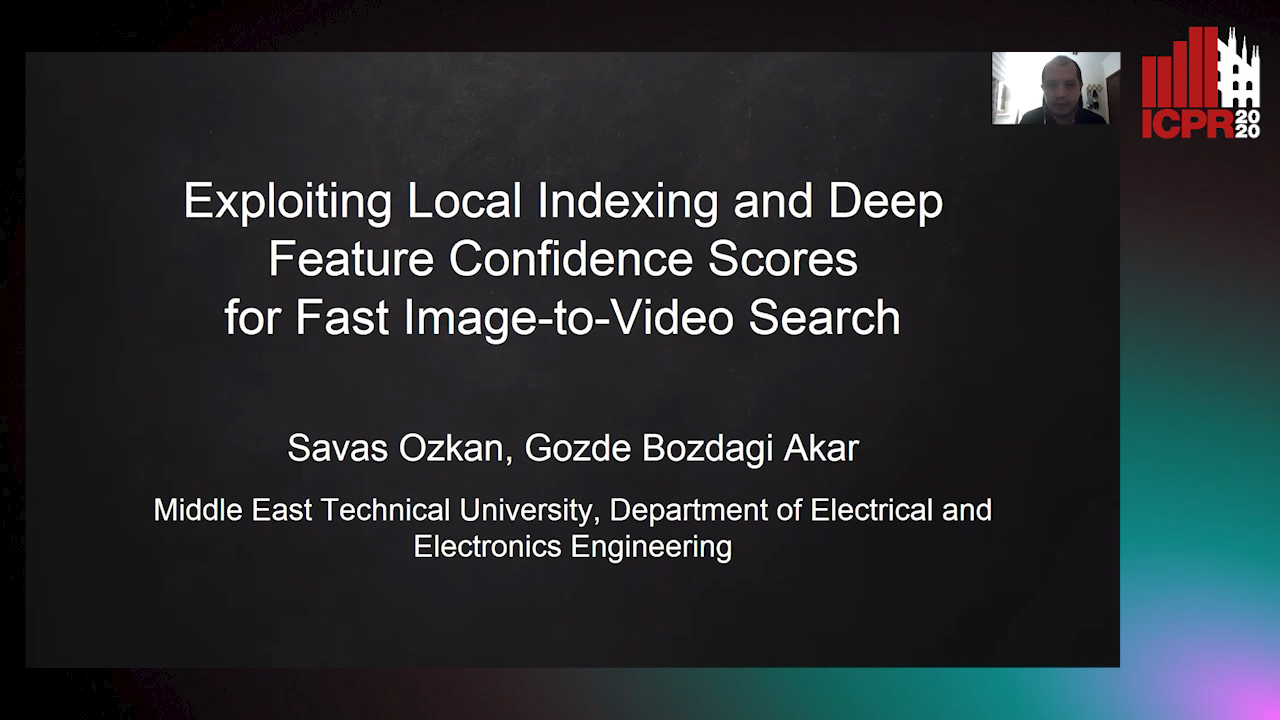
Auto-TLDR; Fast and Robust Image-to-Video Retrieval Using Local and Global Descriptors
Abstract Slides Poster Similar
Facial Expression Recognition by Using a Disentangled Identity-Invariant Expression Representation
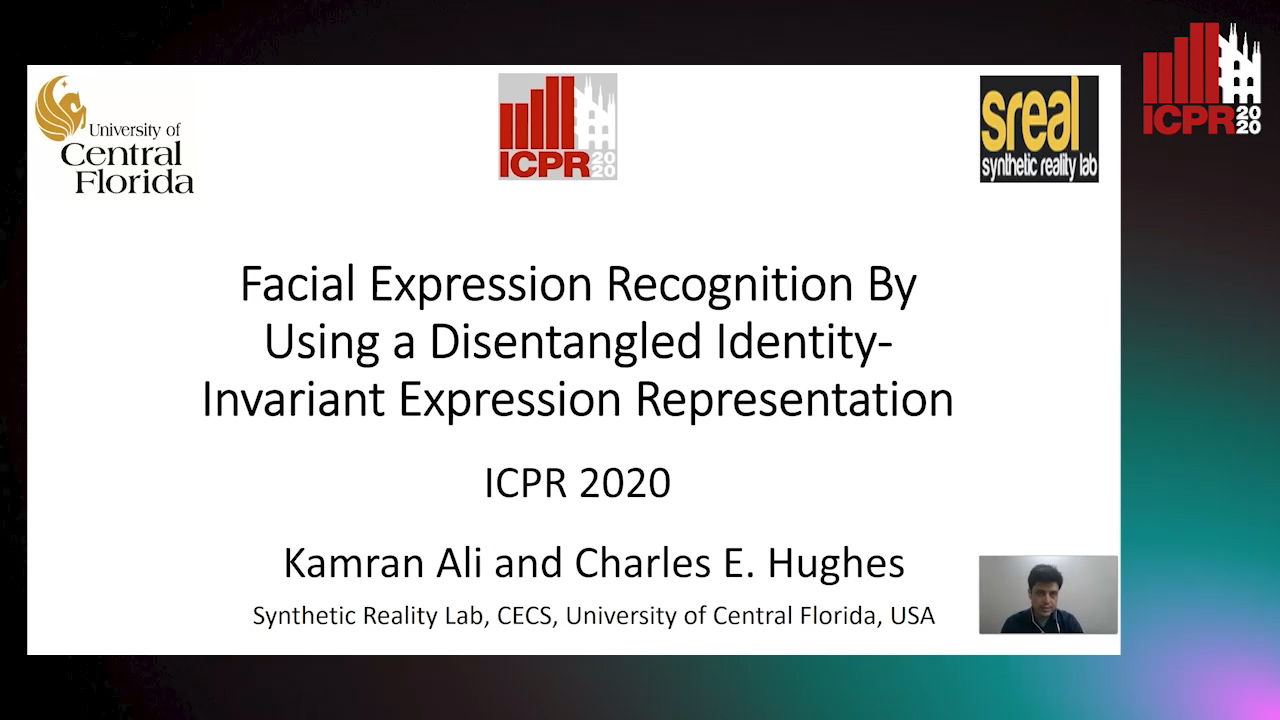
Auto-TLDR; Transfer-based Expression Recognition Generative Adversarial Network (TER-GAN)
Abstract Slides Poster Similar
Generalized Local Attention Pooling for Deep Metric Learning
Carlos Roig Mari, David Varas, Issey Masuda, Juan Carlos Riveiro, Elisenda Bou-Balust

Auto-TLDR; Generalized Local Attention Pooling for Deep Metric Learning
Abstract Slides Poster Similar
G-FAN: Graph-Based Feature Aggregation Network for Video Face Recognition
He Zhao, Yongjie Shi, Xin Tong, Jingsi Wen, Xianghua Ying, Jinshi Hongbin Zha

Auto-TLDR; Graph-based Feature Aggregation Network for Video Face Recognition
Abstract Slides Poster Similar
Rotation Invariant Aerial Image Retrieval with Group Convolutional Metric Learning
Hyunseung Chung, Woo-Jeoung Nam, Seong-Whan Lee

Auto-TLDR; Robust Remote Sensing Image Retrieval Using Group Convolution with Attention Mechanism and Metric Learning
Abstract Slides Poster Similar
Face Image Quality Assessment for Model and Human Perception
Ken Chen, Yichao Wu, Zhenmao Li, Yudong Wu, Ding Liang

Auto-TLDR; A labour-saving method for FIQA training with contradictory data from multiple sources
Abstract Slides Poster Similar
Joint Face Alignment and 3D Face Reconstruction with Efficient Convolution Neural Networks
Keqiang Li, Huaiyu Wu, Xiuqin Shang, Zhen Shen, Gang Xiong, Xisong Dong, Bin Hu, Fei-Yue Wang

Auto-TLDR; Mobile-FRNet: Efficient 3D Morphable Model Alignment and 3D Face Reconstruction from a Single 2D Facial Image
Abstract Slides Poster Similar
Revisiting ImprovedGAN with Metric Learning for Semi-Supervised Learning
Jaewoo Park, Yoon Gyo Jung, Andrew Teoh

Auto-TLDR; Improving ImprovedGAN with Metric Learning for Semi-supervised Learning
Abstract Slides Poster Similar
An Experimental Evaluation of Recent Face Recognition Losses for Deepfake Detection
Yu-Cheng Liu, Chia-Ming Chang, I-Hsuan Chen, Yu Ju Ku, Jun-Cheng Chen
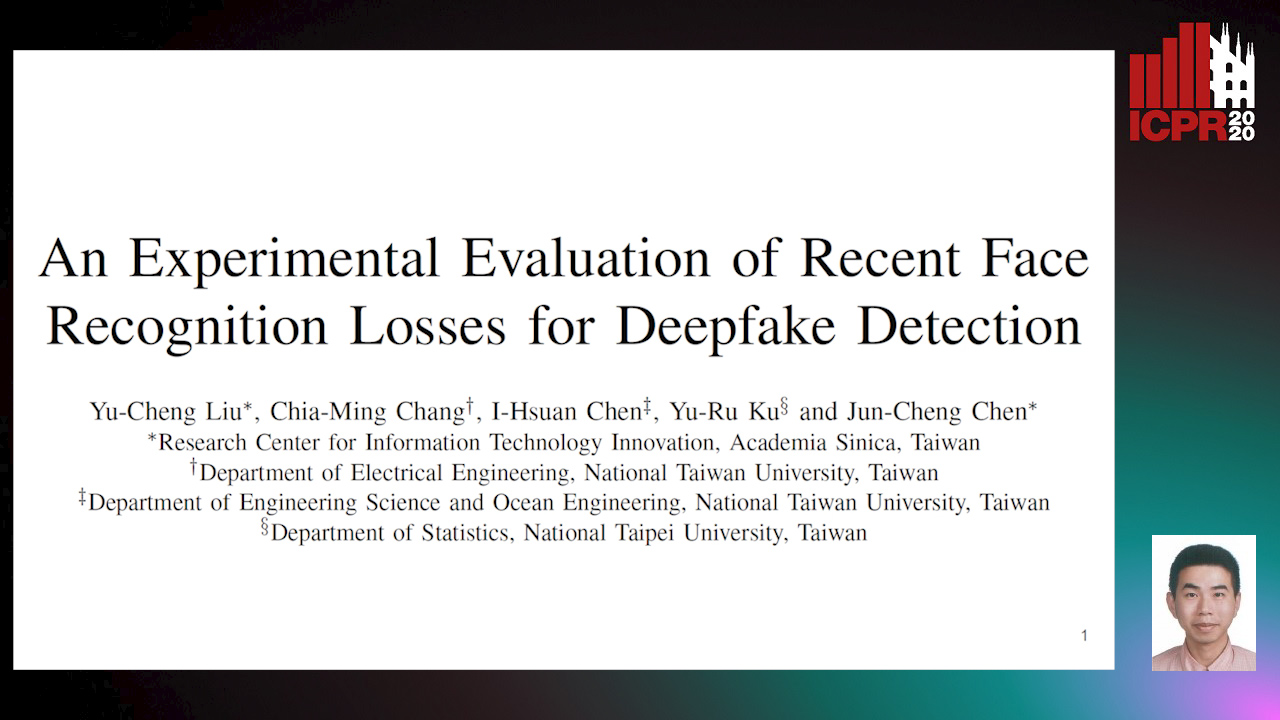
Auto-TLDR; Deepfake Classification and Detection using Loss Functions for Face Recognition
Abstract Slides Poster Similar
Cam-Softmax for Discriminative Deep Feature Learning
Tamas Suveges, Stephen James Mckenna

Auto-TLDR; Cam-Softmax: A Generalisation of Activations and Softmax for Deep Feature Spaces
Abstract Slides Poster Similar
Joint Learning Multiple Curvature Descriptor for 3D Palmprint Recognition
Lunke Fei, Bob Zhang, Jie Wen, Chunwei Tian, Peng Liu, Shuping Zhao

Auto-TLDR; Joint Feature Learning for 3D palmprint recognition using curvature data vectors
Abstract Slides Poster Similar
Building Computationally Efficient and Well-Generalizing Person Re-Identification Models with Metric Learning
Vladislav Sovrasov, Dmitry Sidnev

Auto-TLDR; Cross-Domain Generalization in Person Re-identification using Omni-Scale Network